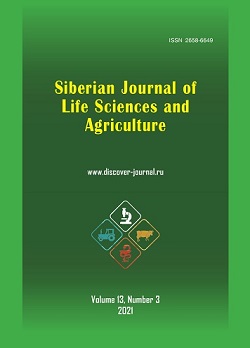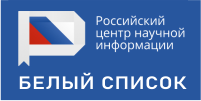КОНЦЕПТУАЛЬНЫЕ ПОДХОДЫ К РАЗВИТИЮ СЕЛЬСКОХОЗЯЙСТВЕННОЙ ОТРАСЛИ В СВЕТЕ ЭКОНОМИКИ ЗАМКНУТОГО ЦИКЛА
Аннотация
Современный этап развития сельскохозяйственной отрасли характеризуется высокими темпами автоматизации производственных процессов. В той связи обостряется проблема рационализации процесса распределения сельскохозяйственных ресурсов и организации производственной цепочки с добавленной стоимостью. В качестве эффективного решения данной проблемы может выступать модель экономики замкнутого цикла. Указанная модель может способствовать рациональному использованию ресурсов, снижению производственных потерь, и, как следствие, - улучшению качества производимой продукции и ее объемов. Необходимо разработать общий план реализации основных постулатов экономики замкнутого цикла в сельском хозяйстве, поэтапно реализовать стратегию круговой экономики и включите новую промышленную круговую экономику в процесс модернизации той или иной отрасли сельского хозяйства. В некоторых областях сельского хозяйства следует как можно скорее создать цикл производственных систем. При базовой реализации новых промышленных технологий и промышленного развития, а также стабильности запасов социальных ресурсов необходимо неуклонно наращивать новый цикл индустриализации в сельском хозяйстве.
Скачивания
Литература
Trifonova T.A., Ilyina M.E. The life cycle and its assessment as an environmental management tool: textbook. Vladimir: Arkaim, 2016, 68 p.
Brown M.T., Ulgiat S. Assessing the global environmental sources driving the geobiosphere: A revised emergy baseline. Ecol. Model., 2016, vol. 339, pp. 126-132. https://doi.org/10.1016/j.ecolmodel.2016.03.017
DrobnikT., Huber R., Grêt-Regamey A. Coupling a settlement growth model with an agro-economic land allocation model for securing ecosystem services provision. J. Environ. Plann. Manag., 2017, vol. 60, no. 7, pp. 111-152. https://doi.org/10.1080/09640568.2016.1197828
Feizizadeh B., Blaschke T. Land suitability analysis for Tabriz County, Iran: a multi-criteria evaluation approach using GIS. J. Environ. Plann. Manag., 2013, vol. 56, no. 1, pp. 1-23. https://doi.org/10.1080/09640568.2011.646964
Ilina A.I. Tsirkulyarnaya ekonomika i tsirkulyarnye biznes-modeli [Circular economy and circular business models]. Saint Petersburg State University, 2018.
Valko D.V. Circular economy: A theoretical model and implementation effects. National Interests: Priorities and Security, 2018, vol. 14, iss. 8, pp. 1415-1429. https://doi.org/10.24891/ni.14.8.1415
Galán-Martin A., Pozo C., Guillén-Gosálbez G., Vaiiejo A.A., Esteller L.J. Multi-stage linear programming model for optimizing cropping plan decisions under the new Common Agricultural Policy. Land Use Pol., 2015, vol. 48, pp. 515-524. https://doi.org/10.1016/j.landusepol.2015.06.022
Batova N., Sachek P., Tochitskaya I. On the Way to Green Growth: Window Opportunities of Circular Economy. BEROC Green Economy Policy Paper Series, 2018. https://beroc.org/en/publications/policy_papers/on_the_way_to_green_growth/
García I.F., Perea R.G., Moreno M.A., Montesinos P., Poyato E.C., J.A.R. Diaz Semi-arranged demand as an energy saving measure for pressurized irrigation networks. Agric. Water Manag., 2017, vol. 193, pp. 22-29. https://doi.org/10.1016/j.agwat.2017.07.025
Giri S., Nejadhashemi A.P. Application of analytical hierarchy process for effective selection of agricultural best management practices. J. Environ. Manag., 2014, vol. 132, pp. 165-177. https://doi.org/10.1016/j.jenvman.2013.10.021
Pakhomova N.V., Richter K.K., Vetrova M.A. Transition to a circular economy and closed supply chains as a factor of sustainable development. Bulletin of St. Petersburg State University. Economy, 2017, vol. 33, no. 2, pp. 244-268. https://doi.org/10.21638/11701/spbu05.2017.203
Brutyan M.M., Vakhromeeva M.P., Vorozheikina T.M. et al. Problemy Sovremennoy Ekonomiki [Problems of modern economy] / ed. Chernova S.S. Novosibirsk, 2016, 262 p.
Houshyar E., Wu X.F., Chen G.Q. Sustainability of wheat and maize production in the warm climate of southwestern Iran: an emergy analysis. J. Clean. Prod., 2018, vol. 172, pp. 2246-2255. https://doi.org/10.1016/j.jclepro.2017.11.187
Tao H., Yuping W., Xiaoyue S., Xianqiang M., Liping L., Hai Y. Foreign Trade Deficit in Term of Resource-Environment and Application of Trade Practices for Achieving Environmental Goals. In: Qu F., Sun R., Guo Z., Yu F. (eds) Ecological Economics and Harmonious Society. Research Series on the Chinese Dream and China’s Development Path. Springer, Singapore. 2016. https://doi.org/10.1007/978-981-10-0461-2_13
Yu Hong, Nico Heerink, Minjuan Zhao, Wopke van der Werf. Intercropping contributes to a higher technical efficiency in smallholder farming: Evidence from a case study in Gaotai County, China. Agric. Syst., 2019, vol. 173, pp. 317-324. http://dx.doi.org/10.1016/j.agsy.2019.03.007
Chunli Du, Jinhua Chen. Soft Cluster Analysis of Circular Economy Development Level in China Regions. Operations Research and Management Science, 2009, vol. 6, pp. 116-122. http://dx.doi.org/10.1109/CSO.2009.114
Serbulova N.M., Gorodnyanskaya A.S., Kanurny S.V. Barriers to the transition to a circular economy. Ekonomika i Predprinimatel’stvo [Economy and entrepreneurship], 2018, no. 3 (92), pp. 978-983.
Ruixin Mu, Integrative Evaluation and Case Study on the Development Level of Circular Economy in the city. Central South University, 2009, pp. 39-41.
Shaanxi Provincial Bureau of Statistics: Shaanxi Statistical Yearbook: 2005-2009 Beijing, China Statistical Publishing House.
Просмотров аннотации: 338 Загрузок PDF: 265
Copyright (c) 2021 Natalia A. Prodanova, Alexander A. Savin, Sergey N. Kosnikov, Ilya V. Sorgutov

Это произведение доступно по лицензии Creative Commons «Attribution-NonCommercial-NoDerivatives» («Атрибуция — Некоммерческое использование — Без производных произведений») 4.0 Всемирная.






















































